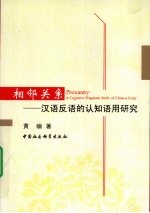

相邻关系 汉语反语的认知语用研究PDF电子书下载
- 电子书积分:11 积分如何计算积分?
- 作 者:黄缅著
- 出 版 社:北京:中国社会科学出版社
- 出版年份:2009
- ISBN:9787500477037
- 页数:266 页
Chapter 1 Introduction 1
1.1 Preliminary remarks 1
1.2 The commitment of the study 4
1.3 The story of irony 6
1.3.1 Origin 6
1.3.2 Irony in Chinese context 7
1.3.3 Classification 11
1.3.4 Uses and functions 16
1.3.5 Summary of the section 21
1.4 Scope of the study 22
1.5 Methodological issues 22
1.5.1 Lead-in remarks 22
1.5.2 Research phases 24
1.6 Data 25
1.7 Structure of the dissertation 26
1.8 Summary 27
Chapter 2 Literature Review 29
2.1 Introduction 29
2.2 Historical survey 30
2.2.1 Greek 30
2.2.2 Latins 33
2.2.3 Mediaeval and Renaissance 35
2.2.4 Early modern times 38
2.2.5 Modern times 40
2.2.6 Brief summary 44
2.3 Theoretical survey abroad 45
2.3.1 Initial remarks 45
2.3.2 Non-cognitive-pragmatic studies 45
2.3.3 Cognitive-pragmatic studies 49
2.3.4 Summary 60
2.4 Research in Chinese context 67
2.4.1 Preliminaries 67
2.4.2 Chronological survey 69
2.5 Remaining crucial problem 75
2.6 Summary 76
Chapter 3 Theoretical Framework 77
3.1 Preliminaries 77
3.2 Methodological constraints 79
3.3 Theoretical background of the present study 81
3.3.1 Main assumptions of cognitive linguistics 82
3.3.2 A brief survey of cognitive pragmatics 88
3.3.3 Theories of human cognitive abilities 94
3.4 Towards a unified theoretical framework 118
3.4.1 MM-based pragmatic reasoning 119
3.4.2 Explicit expression-implicit expression inference 125
3.4.3 Autonomy-dependence alignment 128
3.5 Summary 133
Chapter 4 Issues of Definition and Taxonomy Revisited 136
4.1 Introduction 136
4.2 Definitions of irony revisited 137
4.2.1 Initial remarks 137
4.2.2 Classical identification 138
4.2.3 Modifications 140
4.2.4 Definitions in Chinese context 142
4.3 Three claims reconsidered 143
4.4 Working definition of fan yu 146
4.5 Classification revisited 148
4.6 Taxonomy of verbal irony 152
4.6.1 Positive attitude irony 154
4.6.2 Negative attitude irony 161
4.7 Summary 170
Chapter 5 Irony as a cognitive-pragmatic phenomenon 172
5.1 Introduction 172
5.2 Chinese irony and its pragmatic features 174
5.2.1 Speaker's intention 174
5.2.2 Cancellability 176
5.2.3 Pragmatic vagueness 177
5.2.4 Contextual constraints 179
5.2.5 Indirect communicative act 184
5.3 Chinese irony and its pragmatic functions 186
5.3.1 Sarcasm 187
5.3.2 Politeness 188
5.3.3 Intimacy 191
5.3.4 Humor 191
5.3.5 Praise 192
5.4 Irony seen from the cognitive perspective 193
5.4.1 The cognitive traits of irony 194
5.4.2 Proximity cognition underlying irony 197
5.5 Irony:cognitive-pragmatic interface 200
5.6 Summary 202
Chapter 6 Mechanism of the Use of irony Redescribed 203
6.1 Introduction 203
6.2 Further description of the underlying mechanism 204
6.3 Interpretation of irony 209
6.3.1 Process of interpretation of irony 209
6.3.2 Analyses of examples 213
6.4 Production of irony 219
6.4.1 Process of production of irony 219
6.4.2 Analyses of some examples 222
6.5 Summary 224
Chapter 7 Conclusion 228
7.1 Introduction 228
7.2 Findings and conclusions 229
7.3 Implications 231
7.4 Limitations of our work 233
7.5 Suggestions for further study 235
Dictionaries and Encyclopedias Referred 237
Bibliography 238
Index 257
后记 266
Figure 3-1 Construal of Realities through Conceptualization 87
Figure 3-2 Law of Proximity 110
Figure 3-3 Law of Closure 110
Figure 3-4 Law of Symmetry 111
Figure 3-5 Figure-Ground Segregation 111
Figure 3-6 Law of Continuity 112
Figure 3-7 Law of Similarity 112
Figure 3-8 Different Degrees of Similarity among Three Groups 114
Figure 3-9 Opposite Direction Continuum for Physical Appearance 115
Figure 3-10 Two-Direction Processes of Language Use 119
Figure 3-11 Explicit Expression-Implicit Expression Inferential Process 127
Figure 3-12 Autonomy-Dependence Alignment 133
Figure 3-13 Mechanism Underlying the Use of Irony 134
Figure 4-1 Continuum of Two-Opposite-Direction Meanings of Irony 145
Figure 4-2 Taxonomy offan yu(Chinese irony) 154
Figure 6-1 Two-Stage Process of Irony Comprehension 210
- 《SQL与关系数据库理论》(美)戴特(C.J.Date) 2019
- 《法语词汇认知联想记忆法》刘莲编著 2020
- 《公共关系》胡杏菁,罗永全,连伟文主编 2018
- 《模型与认知》(美)乔纳森·A.瓦斯肯著,魏刘伟译 2019
- 《现代汉语语用否定研究》王志英 2019
- 《认知语言学视野的抽象方位结构研究》曹爽著 2019
- 《人际关系应用心理学》贾海泉 2018
- 《认知破局》王达著 2019
- 《计算机自适应英语语用能力测试系统设计与效度验证 以TEM4词汇与语法题为例》张一鑫著 2019
- 《牛津中国心理学手册 上 认知与学习》(美)迈克尔·哈里斯·邦德主编;赵俊华,张春妹译 2019
- 《写作技法八讲》张继缅著 1986
- 《岩心钻探实用计算》(苏)普·阿·甘朱缅著;高森译 1988
- 《相邻关系 汉语反语的认知语用研究》黄缅著 2009
- 《中华儒学精髓》张继缅著 1995
- 《心智哲学视角下的会话含义研究》黄缅著 2013
- 《红色旅游的社会效应研究》吴春焕著 2019
- 《中国当代乡土小说文库 本乡本土》(中国)刘玉堂 2019
- 《社会学与人类生活 社会问题解析 第11版》(美)James M. Henslin(詹姆斯·M. 汉斯林) 2019
- 《异质性条件下技术创新最优市场结构研究 以中国高技术产业为例》千慧雄 2019
- 《中国铁路人 第三届现实主义网络文学征文大赛一等奖》恒传录著 2019
- 《莼江曲谱 2 中国昆曲博物馆藏稀见昆剧手抄曲谱汇编之一》郭腊梅主编;孙伊婷副主编;孙文明,孙伊婷编委;中国昆曲博物馆编 2018
- 《中国制造业绿色供应链发展研究报告》中国电子信息产业发展研究院 2019
- 《中国陈设艺术史》赵囡囡著 2019
- 《指向核心素养 北京十一学校名师教学设计 英语 七年级 上 配人教版》周志英总主编 2019
- 《《走近科学》精选丛书 中国UFO悬案调查》郭之文 2019
